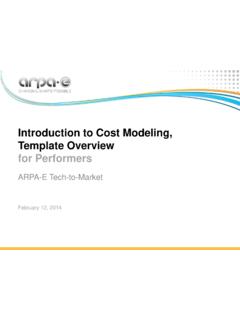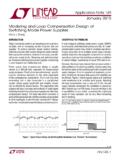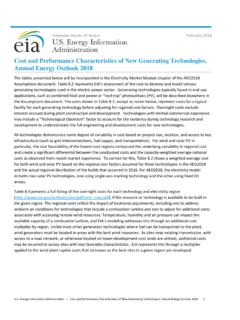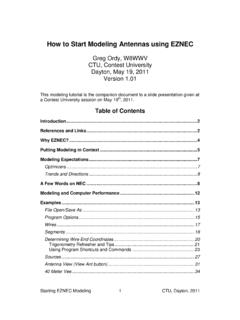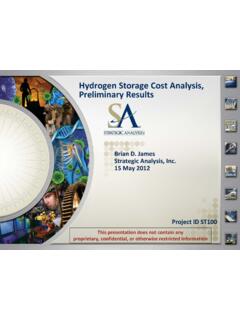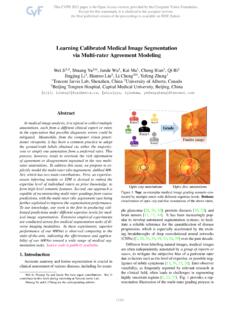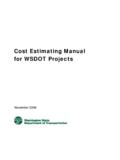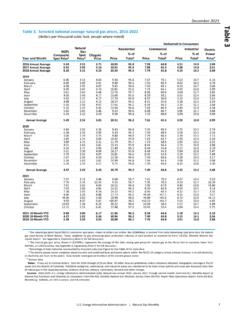Transcription of Financial Modeling: CAPM & WACC
1 Financial modeling : CAPM & WACCP roject made possible through funding by:Project implemented by:IMPROVING THE LEGAL ENVIRONMENT FOR BUSINESS Department of Commerce | CLDPT oday s Presenter:Amit BandoExpert, CLDP, Department of CommerceManaging Partner, BSAS trategic Advisory Services, LLC+1 (301) THE LEGAL ENVIRONMENT FOR BUSINESS Department of Commerce | CLDPOpen Floor for QuestionsPlease use the chat box to submit a question, or use the raise hand feature. If you raise your hand, you will be invited to unmute and ask your keep yourself on mute unless asking a THE LEGAL ENVIRONMENT FOR BUSINESS Department of Commerce | CLDPT oday s Asset Pricing Model (CAPM) Beta Analysis Index and Time Average Cost of Capital (WACC) Iteration Spread Hard Currency vs. Local to CAPM Private Company AnalysisIMPROVING THE LEGAL ENVIRONMENT FOR BUSINESS Department of Commerce | CLDPC apital Asset Pricing Model (CAPM) the relationship between systematic risk and expected returnfor assets, particularly stocks (SPV stock valuation).
2 Is widely used throughout finance for pricing risky securities and generating expected returns for assets given the risk of those assets and cost of THE LEGAL ENVIRONMENT FOR BUSINESS Department of Commerce | CLDPWhat Is Expected Return? The expected return is the amount of profit or loss an investor can anticipate receiving on an investment that has known historical rates of return(RoR). RoRis calculated by multiplying potential outcomes by the chances of them occurring and then totaling these results. Example: If an investment has a 50% chance of gaining 20% and a 50% chance of losing 10%, the expected return would be 5% = (50% x 20% + 50% x -10% = 5%). RoRis essentially a long-term weighted average of historical results, expected returns are not THE LEGAL ENVIRONMENT FOR BUSINESS Department of Commerce | CLDPF ormula for Expected Return of an Asset The formula for calculating the expected return of an asset given its risk isas follows: ERi= Rf + i (ERm Rf) Where: ERi= expectedreturnofinvestment Rf= risk-freerate i = betaoftheinvestment (ERm Rf) = marketriskpremiumIMPROVING THE LEGAL ENVIRONMENT FOR BUSINESS Department of Commerce | CLDPU nderstanding the CAPM (continued) Investors expect to be compensated for risk and the time value of money.
3 The risk-free ratein the CAPM formula accounts for the time value of money. Other components of the CAPM formula account for the investor taking on additional risk. The beta( ) of a potential investment is a measure of how much risk the investment will add to a portfolio that looks like the market. If a stock is riskier than the market, it will have a beta greater than one. If a stock has a beta of less than one, the formula assumes it will reduce the risk of a portfolio. IMPROVING THE LEGAL ENVIRONMENT FOR BUSINESS Department of Commerce | CLDPBeta is a statistical measure of the volatility of a stock versus the overall market Beta is generally used as both a measure of systematic riskand a performance measure. The market has a beta of 1. The beta for a stock describes how much the stock's price moves compared to the market. If a stock has a beta above 1, it's more volatile than the overall market. Example: if an asset has a beta of , it's theoretically 30% more volatile than the market.
4 A beta below 1 means a stock is less volatile than the overall market. If the beta is below 1, the stock either has lower volatility than the market, or it's a volatile asset whose price movements are not highly correlated with the overall market. The price of Treasury bills (T-bills)has a beta lower than 1 because T-bills don't move in relation to the overall market. In the United States, stocks generally have a positive beta since they are correlatedto the market. The S&P 500, Dow Jones Industrial Average, and Nasdaq100 are frequently used beta THE LEGAL ENVIRONMENT FOR BUSINESS Department of Commerce | CLDPU nderstanding the CAPM (continued) An investment project s (stock value of a Special Purpose Vehicle (SPV)) beta is then multiplied by the market risk premium, which is the return expected from the market above the risk-free rate. The risk-free rateis then added to the product of the investment project s beta andthe market risk premium.
5 The result should give investors the required returnor discount ratethey can use to find the value of an asset. IMPROVING THE LEGAL ENVIRONMENT FOR BUSINESS Department of Commerce | CLDPU nderstanding the CAPM (an example) Imagine an investor is contemplating a stock worth $100 per share today that pays a 3% annual dividend. Assume: The stock has a beta compared to the market of , which means it is riskier than a market portfolio. The risk-free rate is 3% and this investor expects the market to rise in value by 8% per year. The expected return of the stock based on the CAPM formula is : = 3% + (8% 3%).IMPROVING THE LEGAL ENVIRONMENT FOR BUSINESS Department of Commerce | CLDPA ssumptions behind the CAPM formula that have been shown not to hold in reality Modern Financial theory rests on two assumptions: (1) Securities markets are very competitive and efficient (that is, relevant information about the companies is quickly and universally distributed and absorbed); (2) These markets are dominated by rational, risk-averse investors, who seek to maximize satisfaction from returns on their investments.
6 IMPROVING THE LEGAL ENVIRONMENT FOR BUSINESS Department of Commerce | CLDPL earning from CAPMD espite its limitations, the CAPM formula is still widely used because it is simple and allows for easy comparisons of investment alternatives. The goal of the CAPM formula is to evaluate whether a(n) (SPV s) stock is fairly valued when its risk and the time value of money are compared to its expected return. The expected return of the CAPM formula is used to discount the expected dividends and capital appreciation of the SPV s stock over the expected holding period. If the discounted value of those future cash flows is equal to $100 then the CAPM formula indicates the stock is fairly valued relative to risk. IMPROVING THE LEGAL ENVIRONMENT FOR BUSINESS Department of Commerce | CLDPBeta Analysis Index Including beta in the formula assumes that risk can be measured by a stock s price volatility: However, price movements in both directions are not equally risky.
7 The look-back period to determine a stock s volatility is not standard because stock returns (and risk) are not normally distributed. The market portfolio that is used to find the market risk premium is only a theoretical value: It is not an asset that can be purchased or invested in as an alternative to the stock. Most of the time, investors will use a major stock index, like the S&P 500, to substitute for the market, which is an imperfect comparison. IMPROVING THE LEGAL ENVIRONMENT FOR BUSINESS Department of Commerce | CLDPBeta Analysis Time Periods Assumes that the risk-free rate will remain constant over the discounting period. If (in the previous example) the interest rate on Treasury bonds rose to 5% or 6% during the 10-year holding period. An increase in the risk-free rate also increases the cost of the capital used in the investment and could make the stock look overvalued. IMPROVING THE LEGAL ENVIRONMENT FOR BUSINESS Department of Commerce | CLDPA ssumptions behind the CAPM formula that have been shown not to hold in reality CAPM Relies on Assumptions about Investor Behaviors, Risk and Return Distributions, and Market Fundamentals that do not Match Reality The most serious critique of the CAPM is the assumption that future cash flows can be estimated for the discounting process.
8 If an investor could estimate the future return of a investment (stock) with a high level of accuracy, the CAPM would not be necessary. IMPROVING THE LEGAL ENVIRONMENT FOR BUSINESS Department of Commerce | CLDPD iscussion & Excel Spreadsheet DemonstrationIMPROVING THE LEGAL ENVIRONMENT FOR BUSINESS Department of Commerce | CLDPWhat Is Weighted Average Cost of Capital WACC? The weighted average cost of capital (WACC) is a calculation of a project's (firm s) cost of capitalin which each category of capital is proportionately weighted. All sources of capital, including common stock, preferred stock, bonds, and any other long-term debt, are included in a WACC calculation. The WACC increases as the beta and rate of return on equity increase because an increase in WACC denotes a decreasein valuation and an increasein risk. IMPROVING THE LEGAL ENVIRONMENT FOR BUSINESS Department of Commerce | CLDPWACC Formula and Calculation WACC = E/V Re + D/V Rd (1 Tc)Where:Re= CostofequityRd= CostofdebtE = Marketvalueofthefirm sequityD = Marketvalueofthefirm sdebtV = E + D = To t a lmarketvalueofthefirm sfinancingE/V= Percentageoffinancingthatis equityD/V= Percentageoffinancingthatis debtTc= CorporatetaxrateIMPROVING THE LEGAL ENVIRONMENT FOR BUSINESS Department of Commerce | CLDPC alculating WACC To calculate WACC, multiply the cost of each capital component by its proportional weight.
9 The sum of these results, in turn, is multiplied by 1 minus the corporate tax rate. Calculation of a project s (firm's) cost of capital in which each category of capital is proportionately weighted. Incorporates all sources of a capital including common stock, preferred stock, bonds, and any other long-term THE LEGAL ENVIRONMENT FOR BUSINESS Department of Commerce | CLDPL earning from WACC Debt and equity are the two components that constitute a project s/company s capital funding. Lenders and equity holders will expect to receive certain returns on the funds or capital they have provided. Since the cost of capital is the return that equity owners (or shareholders) and debt holders will expect: WACC indicates the return that both kinds of stakeholders (equity owners and lenders) can expect to receive. Put another way, WACC is an investor s opportunity cost of taking on the risk of investing money in a THE LEGAL ENVIRONMENT FOR BUSINESS Department of Commerce | CLDPWho Uses WACC?
10 Analysts frequently use WACC when assessing the value of investments and when determining which ones to pursue. In discounted cash flow(DCF) analysis, one may apply WACC as the discount rate for future cash flows in order to derive a business's net present value (NPV). WACC may also be used as a hurdle rate against which companies and investors can gauge return on invested capital(ROIC) performance . WACC is also essential in order to perform economic value-added (EVA) calculations. Investors may often use WACC as an indicator of whether or not an investment is worth pursuing. WACC is the minimum acceptable rate of return at which a company yields returns for its investors. To determine an investor s personal returns on an investment in a company, simply subtract the WACC from the company s returns percentage. IMPROVING THE LEGAL ENVIRONMENT FOR BUSINESS Department of Commerce | CLDPWhen the required rate of return is equal to the cost of capital, it sets the stage for a favorable required rate of returnis the minimum return an investor will accept for owning a company's stock, as compensation for a given level of riskassociated with holding the stock.


